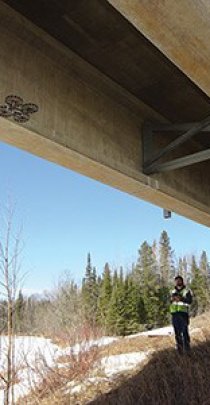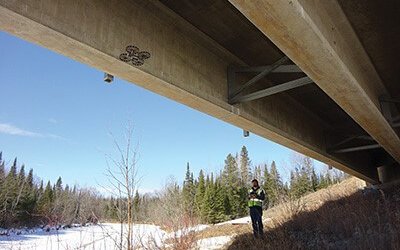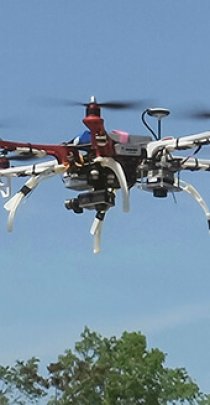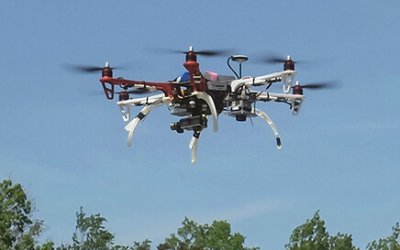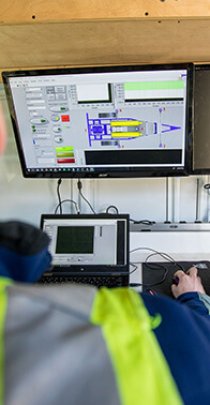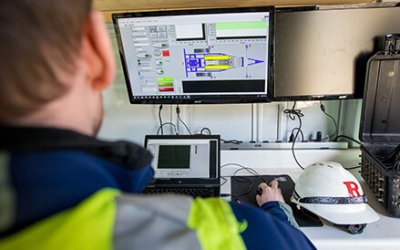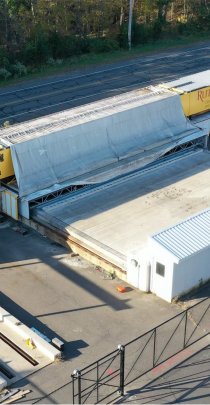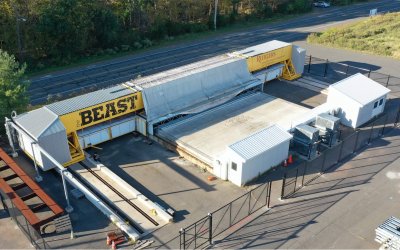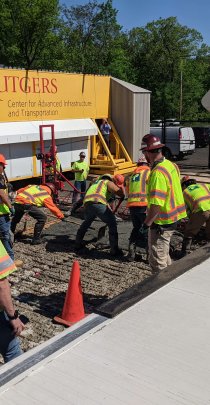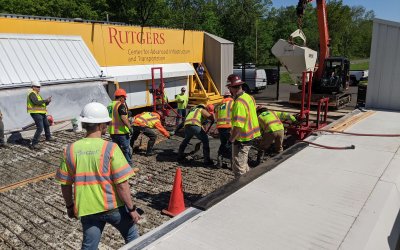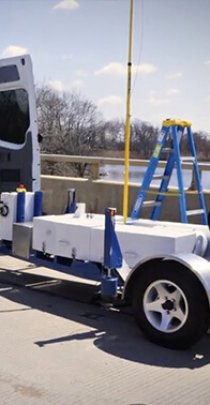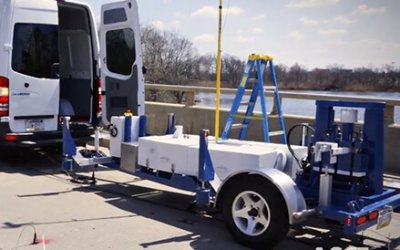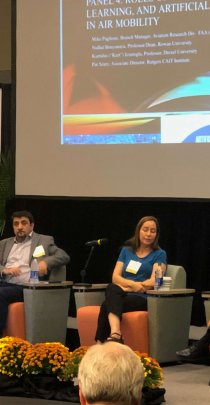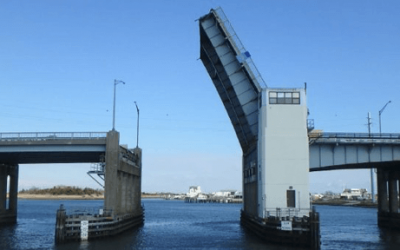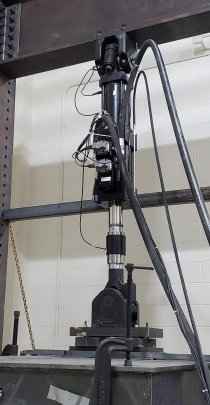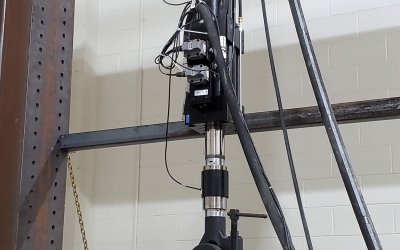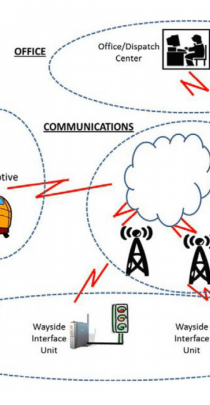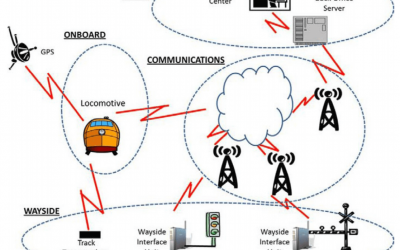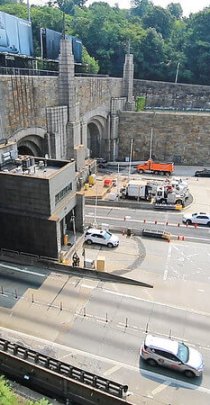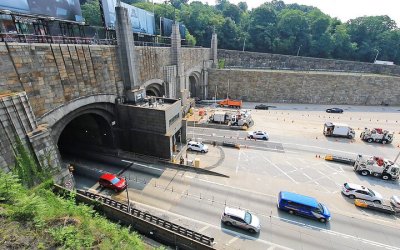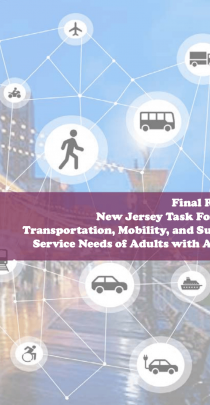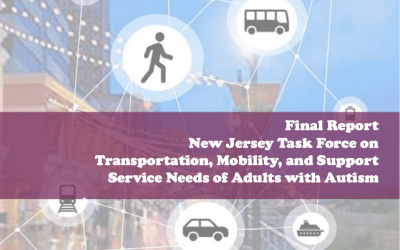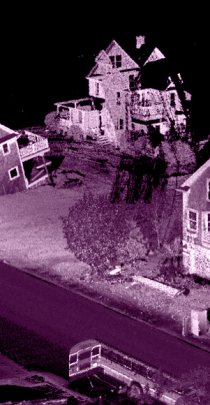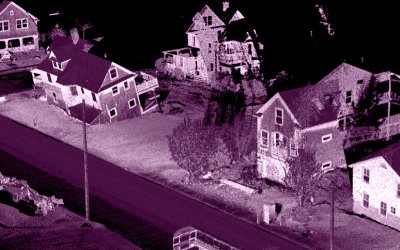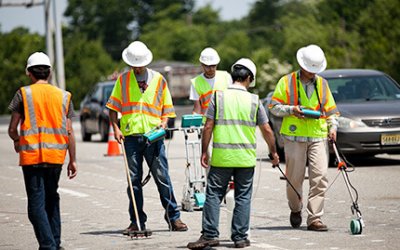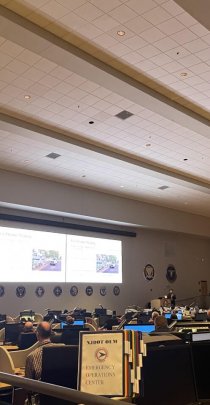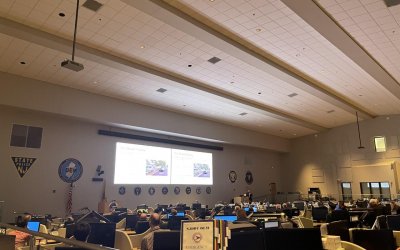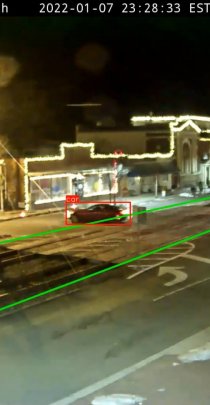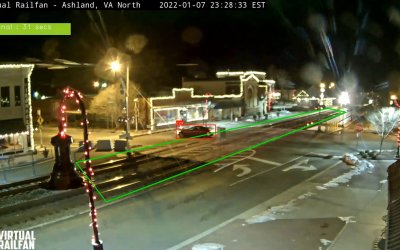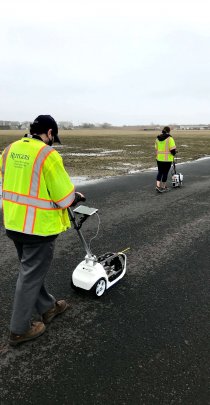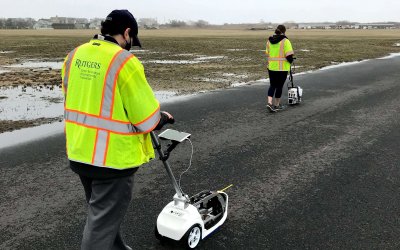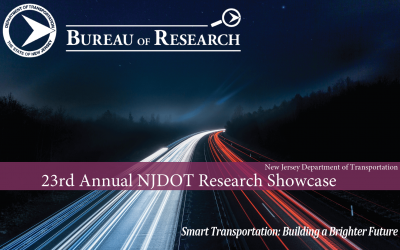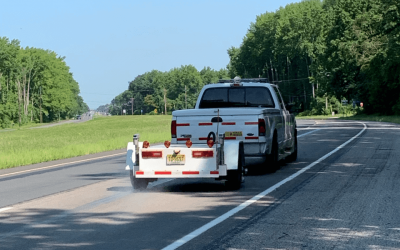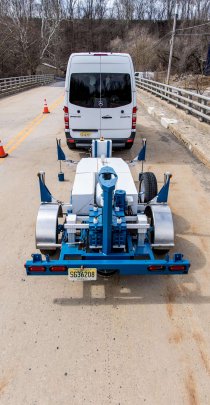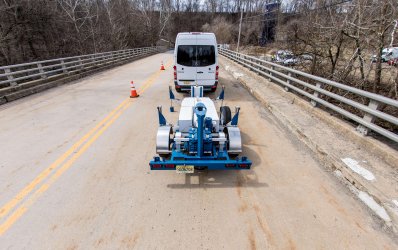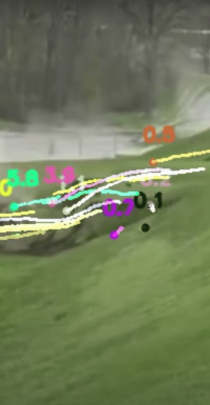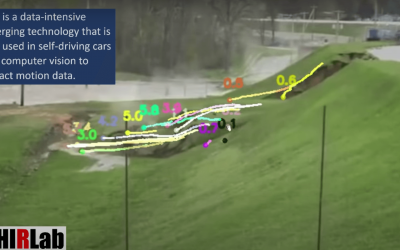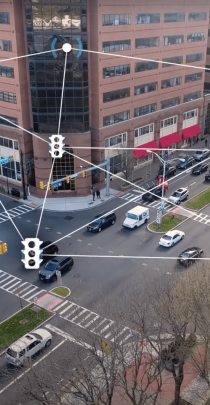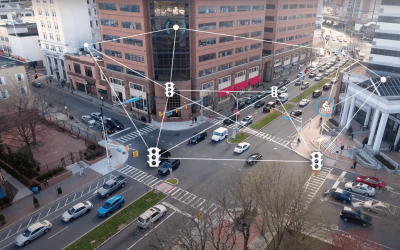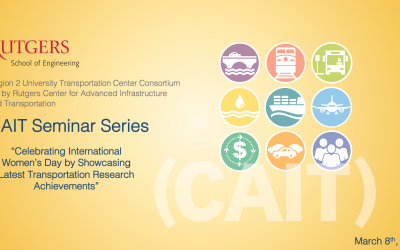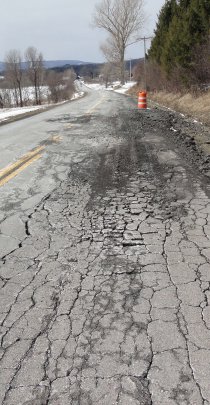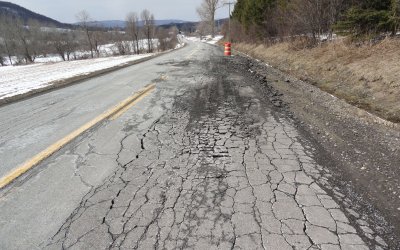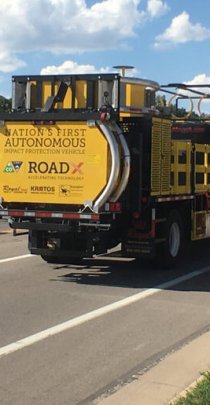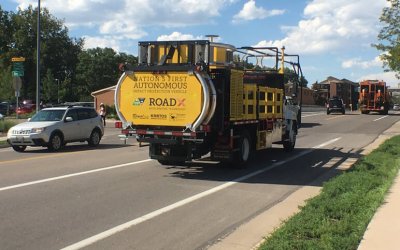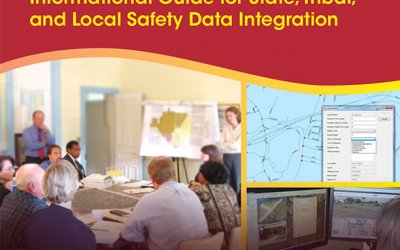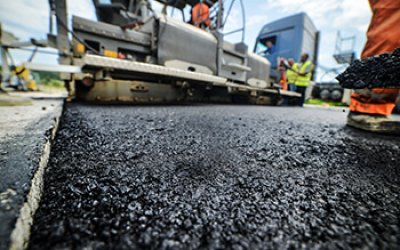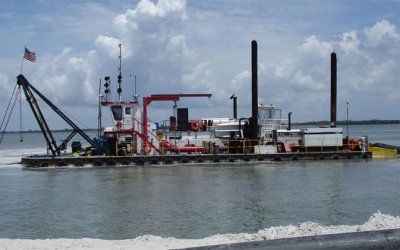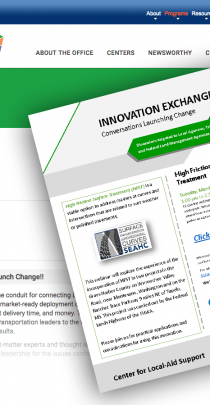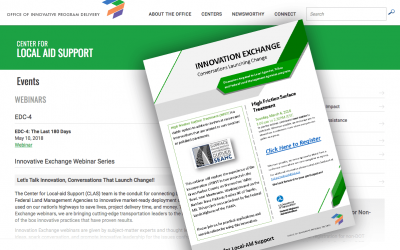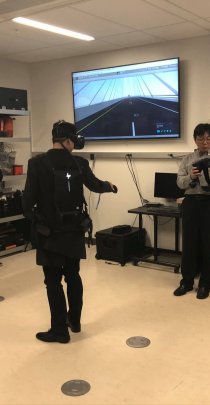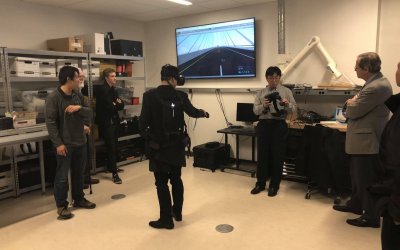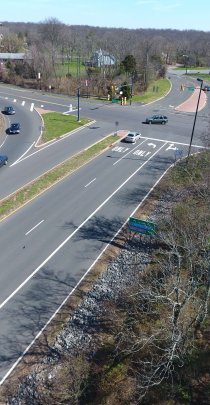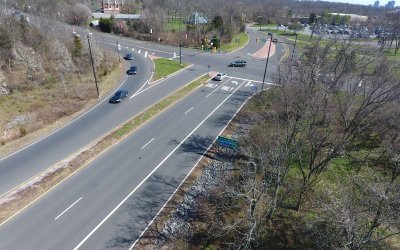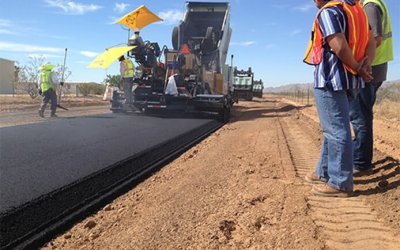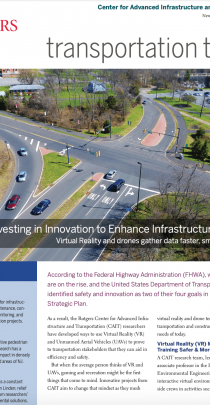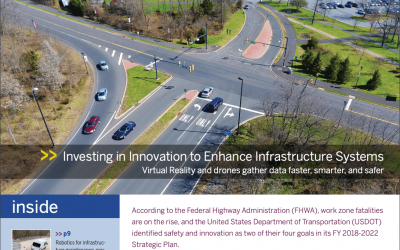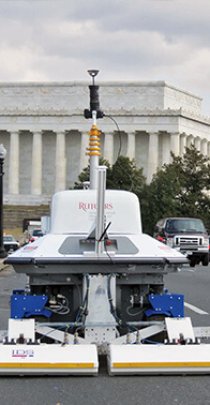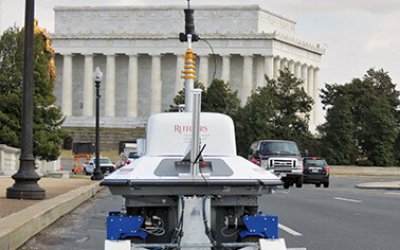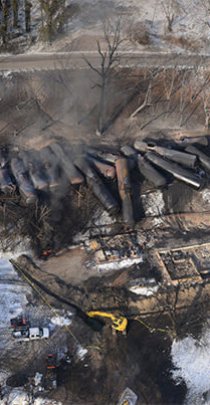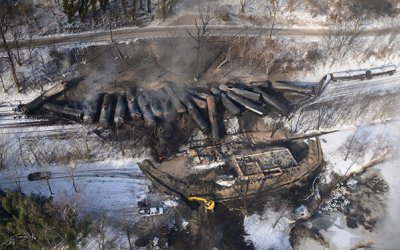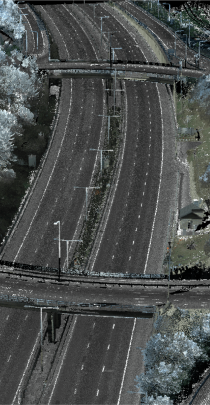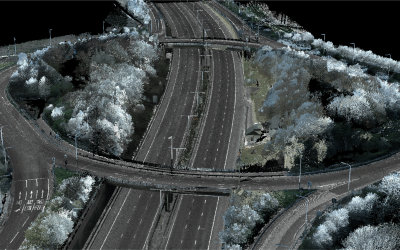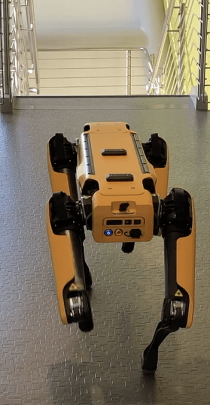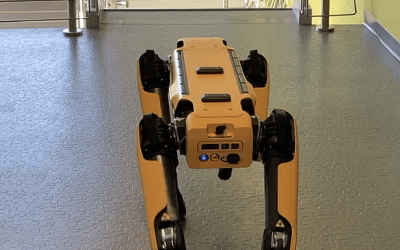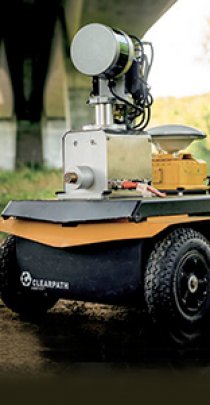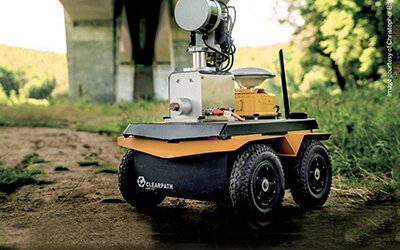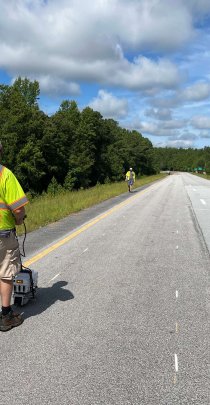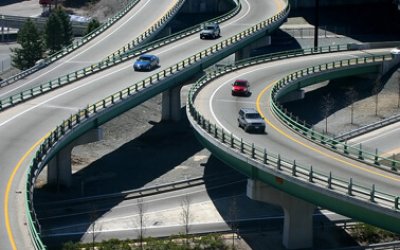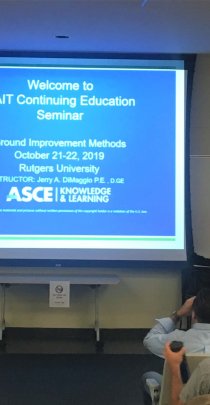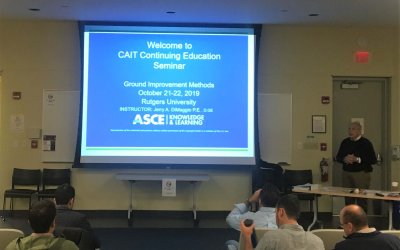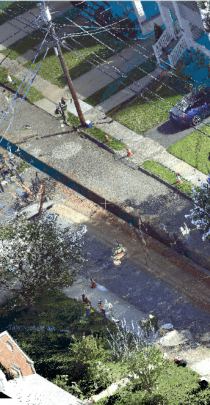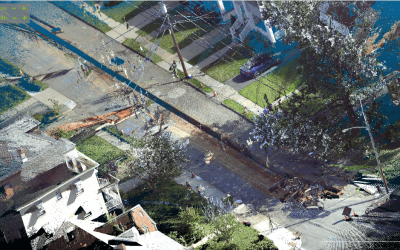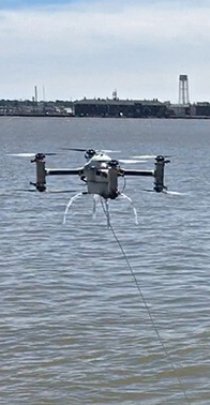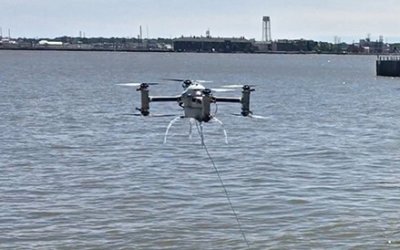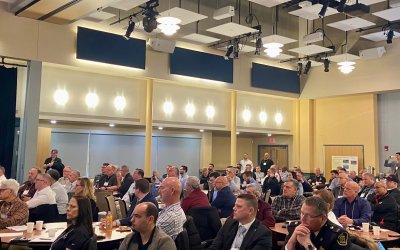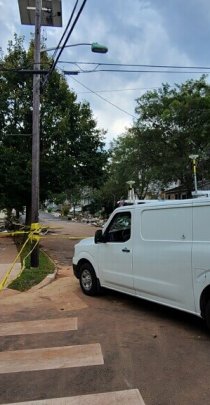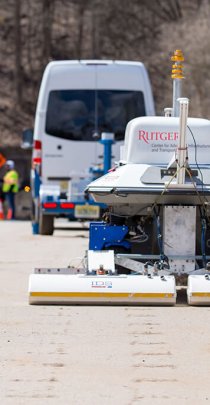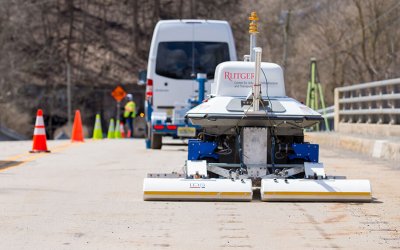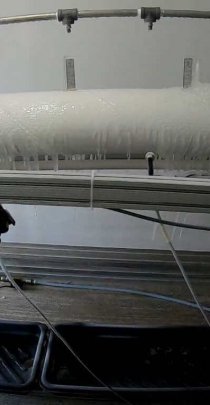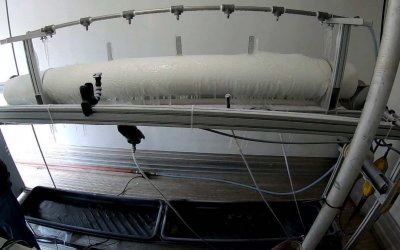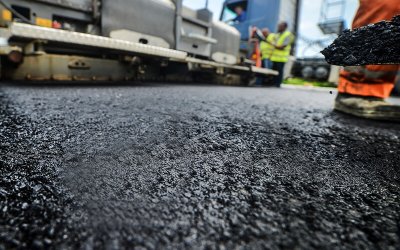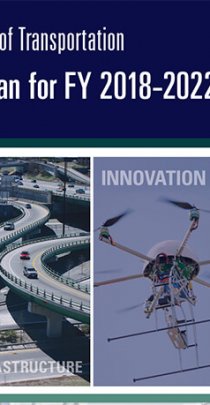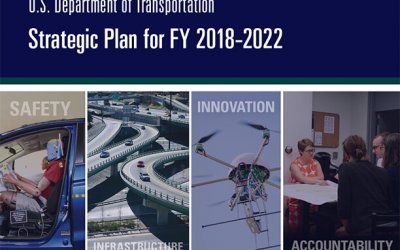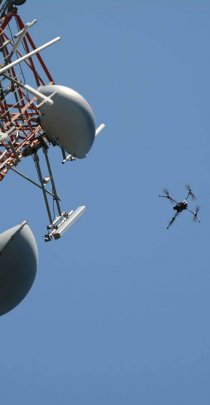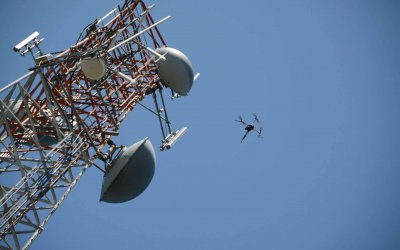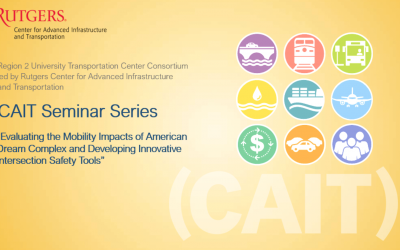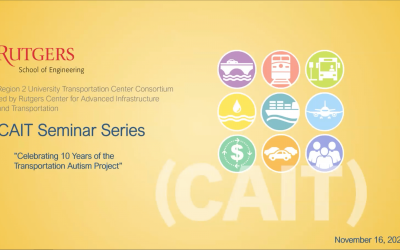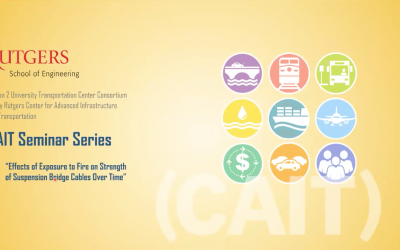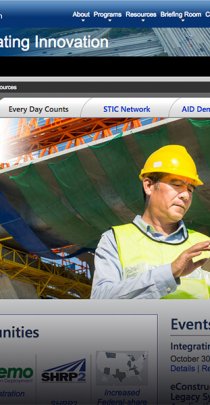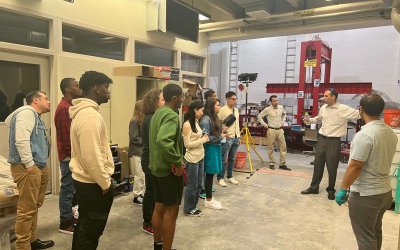Practical solutions to real-world problems. CAIT creates technologies and products and quickly puts them in the hands of transportation practitioners for tackling some their toughest challenges.
Training & Events
NJLTAP - Principles of Paving (In-Person)
This course is for municipal or county employees and those that work with them who are involved in the planning, inspecting and placing of asphalt pavements. The course will provide the information needed to properly plan and monitor a hot mix asphalt paving project.
News
A new view for bridge inspectors
Connected directly to a drone’s video feed, first-person view (FPV) goggles allow bridge inspectors to get up close and personal with the components they are examining. FPVs provide a perspective that is equivalent to what they would see from about three feet away.
For students who dream of flying
A grant from the NSF helped launch Atlantic Cape Community College’s new associate’s degree program in applied science with a concentration on small commercial drone field technicians.
APWA Announces new “Public Works First Responder” symbol
The American Public Works Association (APWA) is proud to announce creation of a national “Public Works First Responder” symbol that recognizes public works professionals’ federally mandated role as first responders.
THMPER featured in Civil Engineering magazine
The February 2018 issue of CE magazine featured THMPER—a portable, rapid testing device for bridge load-bearing capacity. THMPER is a breakthrough because it does this critical task faster, cheaper, and with less traffic disruption than other current methods.
ASCE Features NYC Digital Twin Research By UTC Partners at Columbia
A three-year project at Columbia University is building Digital Twins of intersections, roadways, and other key infrastructure in New York City to monitor and map traffic flow throughout the city. Using Digital Twins can help officials simulate traffic and congestion conditions and test potential mitigation strategies.
UHPC Bridge Preservation & Repair Research at The BEAST
CAIT's BEAST Lab has been testing a full-scale, 50-ft. bridge deck for a project sponsored by the FHWA to learn about how the bridge deteriorates under exposure to extreme environmental conditions and traffic loading — and to evaluate emerging bridge preservation technologies such as UHPC.
BEAST Lab Studies Innovative UHPC Material for Bridge Preservation & Repair
This summer, the BEAST Lab at Rutgers CAIT began to evaluate emerging bridge preservation technologies in addition to ongoing testing of a full-scale, 50-ft. bridge deck. Specifically, researchers started investigating UHPC to establish measurements of the material’s long-term performance under real-world conditions.
Bridge evaluation device lands prestigious Pankow Innovation Award
THMPER determines bridge load ratings faster, cheaper, and with less traffic disruption than other current methods. A portable evaluation tool and data lab, it employs three refined methods outlined by AASHTO: modal impact testing, refined analysis, and calibration of FE element models.
Building connections that last
FHWA is promoting ultra-high performance concrete to improve the strength, simplicity, and durability of prefabricated bridge element connections. This innovation builds on field experience of dozens of states in the U.S. since 2009.
Associate Director Elected Secretary of Council of University Transportation Centers
The Associate Director of CAIT, Dr. Patrick Szary, has served on the executive committee of CUTC previously as well as playing an instrumental role in both leading CAIT’s research in aligning with the national vision of USDOT while also engaging regional stakeholders and developing the Center as a dynamic resource.
CAIT Associate Director Elected CUTC VP for 2021-2022
Dr. Szary leads CAIT’s research efforts helping to align them with USDOT’s national vision and the needs of stakeholders in the Northeast region. He has been a member of CUTC’s executive board previously, most recently serving as Secretary last year.
UAS Conference Addresses Future of Air Mobility
The three-day event featured panelists from NASA, FAA, universities, industry, and more including associate director of Rutgers CAIT Dr. Pat Szary who presented on the safety and security roles that AI might play in the future of air mobility. A major theme of the event was addressing next steps in further implementing UAS.
CAIT Awarded $3.5 million from USDOT UTC program
Rutgers’ CAIT was awarded a $3.5 million grant from USDOT’s Research and Innovative Technology Administration under the University Transportation Center (UTC) program. This is the third time CAIT has successfully competed to retain its UTC status.
CAIT Awarded Bridge Resource Program to Support NJDOT Research
The BRP is aimed at preserving bridges in the state, enhancing the condition of key transportation infrastructure, and developing new technologies to help engineers build with resilience in mind.
CAIT Develops Flood Risk & Resilience Analysis Tool with US Virgin Islands
Working with the University of the Virgin Islands, CAIT researchers have developed a Flood Risk and Resilience Analysis Tool that can assess and visualize risk for roadways and other infrastructure susceptible to flooding and storms. It was built based on real flood data and the US Virgin Islands transportation system.
CAIT Director Named to NJ’s Restart and Recovery Advisory Council
New Jersey Governor Phil Murphy recently announced the formation of a statewide council of leaders from various industry, community, and faith-based groups and institutions across New Jersey to work together and advise on the state’s restart and recovery from the COVID-19 pandemic.
CAIT Expands Large-Scale Testing Equipment for Bridge-Deck Development Research
Rutgers CAIT recently enhanced capability in large-scale structural-testing equipment that will enable full utilization of its existing laboratory infrastructure and expand its portfolio in transportation research by providing access to a capability that currently does not exist in any other university in NJ and the region.
CAIT experts testify before NJ Assembly transportation committee
CAIT director Dr. Ali Maher and civil engineering professor Dr. Franklin Moon offered their thoughts on New Jersey infrastructure and encouraged lawmakers to view researchers in higher education as a resource and partner for finding solutions to the state’s pressing issues.
CAIT pavement crew wants agencies to join the RAAT-Pack
Modern asphalt pavement performance testing has evolved quickly. The physical testing procedures are relatively simple, but analyzing the collected data is complex and intensive. If you’re an asphalt technician or engineer, that’s where RAAT-Pack has your back.
Two New Studies from CAIT Analyze End-of-Track Collision Prevention Strategies
While extensive research has been done on train safety related to derailments and other areas, the same cannot be said for end-of-track collisions at passenger terminals. The Rail and Transit Program at Rutgers CAIT has taken an active research role in addressing this.
Best Practices for Deploying Real-Time Traffic Signal Performance Monitoring
Traffic congestion costs the US billions each year in productivity as commuters find themselves stuck on the nation’s crowded roadways. As more people use the transportation system, investment in innovative, intelligent technology is needed to ensure that current infrastructure can support the growing need.
CAIT Research Helps Port Authority Adopt Leading Sustainable Concrete Standards
New Low-Carbon Concrete Requirements Mark Significant Milestone in Agency’s Clean Construction Program; Advance Agency’s Commitment to Reducing Direct Emissions.
Autonomous Vehicles And More Discussed at USDOT Accessibility Summit
Dr. Cecilia Feeley, Transportation Autism Project Manager at CAIT, was among the researchers personally invited to attend the summit. Her breakout group was primarily focused on the emerging autonomous vehicle market and ways to make sure this technology is inclusive for all.
CAIT Researcher Helps NJ Lessen Barriers to Transportation Support Services
A new report from the New Jersey Task Force on Transportation, Mobility, and Support Service Needs of Adults with Autism highlights and identifies State policies and programs that can be improved to help remove or lessen barriers and enhance access to transportation for those with disabilities.
CAIT Researcher Participates in GatewayJFK "On the Move" Industry Event
GatewayJFK "On the Move" celebrated industry, community partners, government, residents and next generation Movers & Shakers in the off-airport cargo and supply chain community.
CAIT Researcher Speaks at Capitol Hill on Gaps in Infrastructure Resilience
The Coastal Universities Coalition is a consortium of the nation’s leading academic institutions convened to develop science-based solutions to the most pressing issues facing populated coastal regions. This month, a CAIT researcher was invited by the organization to speak on infrastructure resilience.
CAIT Researcher Speaks on the State-of-the-Art in NDE and Bridge Assessment Tech
On September 16th from 2-3 pm, Rutgers Center for Advanced Infrastructure and Transportation (CAIT) hosted affiliated researcher Dr. Nenad Gucunski for a presentation on the state-of-the-art in the use of Nondestructive Evaluation and other technologies for the comprehensive assessment of concrete bridges.
CAIT Researcher Trains NJ Agencies on Statewide Resilience Planning Using New Tech
Dr. Jie Gong gave a 3-hour course earlier this fall on statewide infrastructure resilience to storms, flooding, and other natural disasters at the NJ Regional Intelligence Operation Center.
CAIT Researcher Validates Paratransit Skills Assessment and Wins TRB Best Paper Award
A recent paper from Rutgers CAIT validated the Paratransit Skills Assessment and found it can predict an individual's ability to use paratransit services with greater than 96% accuracy.
CAIT Researcher Wins ASCE Huber Prize Recognizing His Research Achievements
The Walter L. Huber Civil Engineering Research Prizes are awarded to ASCE members for notable achievements in research related to civil engineering. Dr. Hao Wang was recognized by ASCE with a Huber Prize this year for his innovative research developing sustainable, durable, resilient, and smart pavement systems.
CAIT Researcher Recognized at 21st Annual NJDOT Research Showcase
This year, a Rutgers and CAIT-affiliated faculty member took home the 2019 NJDOT Research Implementation Award for his innovative work on the development of a new protocol for accepting new coating systems.
Researchers Contribute to Center of Excellence Developing Threat Assessment Solutions
Rutgers CAIT researchers Dr. Peter Jin and Dr. Jie Gong are contributing research on digital twin projects as part of a new Center of Excellence for Engineering Secure Environments from Targeted Attacks at Rutgers University that will combat potential threats to buildings, schools, stadiums, and other infrastructure.
CAIT Researchers Create AI Tool for Railroad Trespassing Detection
The system analyzes video footage to detect illegal pedestrian activity and deliver data to help reduce preventable train strikes.
CAIT Researchers Evaluate New Equipment to Help NJ Monitor Pavement Condition
Inaccurate network pavement data can impact pavement management decisions such as roadway repairs and more. CAIT researchers at the Rutgers Asphalt Pavement Lab are working with NJDOT to test new pavement inspection equipment and locations to ensure data is accurate and representative of roads in New Jersey.
CAIT Researchers Featured for Innovative ‘Engineering Advances’ Across New Jersey
CAIT researchers have been driving advanced engineering solutions into practice here in NJ. A few experts at CAIT were highlighted by NJBIZ last month in an article on "Engineering Advances."
CAIT Researchers Present, Win Awards at 23rd Annual NJDOT Research Showcase
The 23rd Annual NJDOT Research Showcase was an opportunity for the New Jersey transportation community to learn about the broad scope of academic research initiatives underway and share technology transfer activities being conducted by institutions of higher education partners and their associates.
CAIT Researchers Test HFST Across NJ for Performance and Service Life
A report from CAIT researcher Dr. Thomas Bennert, in collaboration with stakeholders from NJDOT, tests the performance of existing High Friction Surface Treatment installations at locations in New Jersey, as well as the viability of alternatives such as High Friction Chip Seal for areas showing signs of premature failure.
CAIT Researchers Will Use AI-powered Technology to Make Public Transit Safer
Artificial Intelligence can help reduce pedestrian and vehicle accidents along NJ TRANSIT’s Hudson-Bergen Light Rail line and beyond.
CAIT chosen to lead USDOT Region 2 University Transportation Center
The Region 2 UTC consortium is focusing on developing practical tools and methods to improve infrastructure health, durability, and resilience. Partners are: Atlantic Cape Community College, Columbia, Cornell, NJIT, Polytechnic University of Puerto Rico, Princeton, Rowan, SUNY–Farmingdale, and University at Buffalo.
CAIT Seminar Series: A Seminar on Port Logistics
On October 20th from 12 noon to 2 pm, the Rutgers Center for Advanced Infrastructure and Transportation (CAIT) will host a seminar on port logistics. Click here to learn more and register.
CAIT Seminar Series: State-of-the-Art in the Use of Nondestructive Evaluation
On Wednesday, September 16th, from 2-3 pm, Rutgers Center for Advanced Infrastructure and Transportation (CAIT) will host the next installment of its ongoing seminar series on the state of the art in nondestructive evaluation (NDE) and other technologies for the assessment of concrete bridges.
CAIT Seminar: Developing the DataCity Smart Mobility Testing Ground
On Thursday February 23rd, CAIT researcher Dr. Peter Jin hosted a seminar discussing the DataCity Smart Mobility Testing Ground, its implementation throughout the test corridor, data collected from the project so far, and next steps in the DataCity program.
CAIT Showcases DataCity Lab at Middlesex County’s Inaugural Transportation Symposium
State transportation leaders gathered to learn about mobility and infrastructure projects happening in Middlesex County.
CAIT Update, April 2021
News from the USDOT Region 2 University Transportation Center led by Rutgers CAIT.
CAIT Update, April 2022
News from the USDOT Region 2 University Transportation Center led by Rutgers CAIT.
CAIT Update Enews, August 2019
News from the USDOT Region 2 University Transportation Center led by Rutgers Center for Advanced Infrastructure and Transportation. Includes stories on recent events, research, and faculty accomplishments and activities.
CAIT Update, August 2020
News from the USDOT Region 2 University Transportation Center led by Rutgers CAIT.
CAIT Update, December 2019
News from the USDOT Region 2 University Transportation Center led by Rutgers CAIT.
CAIT Update, December 2020
News from the USDOT Region 2 University Transportation Center led by Rutgers CAIT.
CAIT Update, December 2021
News from the USDOT Region 2 University Transportation Center led by Rutgers CAIT.
CAIT Update, December 2022
News from the USDOT Region 2 University Transportation Center led by Rutgers CAIT.
CAIT Update, February 2020
News from the USDOT Region 2 University Transportation Center led by Rutgers CAIT.
CAIT Update, February 2021
News from the USDOT Region 2 University Transportation Center led by Rutgers CAIT.
CAIT Update, February 2023
News from the USDOT Region 2 University Transportation Center led by Rutgers CAIT.
CAIT Update, January 2020
News from the USDOT Region 2 University Transportation Center led by Rutgers CAIT.
CAIT Update Enews, July 2019
News from the USDOT Region 2 University Transportation Center led by Rutgers Center for Advanced Infrastructure and Transportation. Includes stories on recent events, research, and faculty accomplishments and activities.
CAIT Update, July 2020
News from the USDOT Region 2 University Transportation Center led by Rutgers CAIT.
CAIT Update, July 2021
News from the USDOT Region 2 University Transportation Center led by Rutgers CAIT.
CAIT Update, Jun 2020
News from the USDOT Region 2 University Transportation Center led by Rutgers CAIT.
CAIT Update, June 2021
News from the USDOT Region 2 University Transportation Center led by Rutgers CAIT.
CAIT Update, March 2020
News from the USDOT Region 2 University Transportation Center led by Rutgers CAIT.
CAIT Update Enews, May 2019
News from the USDOT Region 2 University Transportation Center led by Rutgers Center for Advanced Infrastructure and Transportation. Includes stories on recent conferences, research, and faculty accomplishments and activities.
CAIT Update, April 2020
News from the USDOT Region 2 University Transportation Center led by Rutgers CAIT.
CAIT Update, November 2019
News from the USDOT Region 2 University Transportation Center led by Rutgers CAIT.
CAIT Update, November 2020
News from the USDOT Region 2 University Transportation Center led by Rutgers CAIT.
CAIT Update, October 2019
News from the USDOT Region 2 University Transportation Center led by Rutgers CAIT.
CAIT Update, October 2022
News from the USDOT Region 2 University Transportation Center led by Rutgers CAIT.
CAIT Update, September 2020
News from the USDOT Region 2 University Transportation Center led by Rutgers CAIT
CAIT Update, September 2021
News from the USDOT Region 2 University Transportation Center led by Rutgers CAIT.
CAIT Update, September 2022
News from the USDOT Region 2 University Transportation Center led by Rutgers CAIT.
CAIT Works with NJ Transit on Innovative Autonomous Shuttle Solutions
Self-driving shuttles are one part of NJ Transit’s future plans for filling in the gap on first and last-mile transit options. The agency hopes to test this technology as part of an innovative pilot program that Rutgers CAIT has partnered with them on.
CAIT-affiliated Researcher Named National Academy of Inventors Senior Member
The National Academy of Inventors (NAI) has named Mehdi Javanmard a senior member. He is one of 95 of the foremost emerging academic inventors identified by NAI’s member institutions to be welcomed to the 2023 class of senior members.
CAIT-Affiliated Researcher to Study New Tech to Better Prepare for Future Pandemics
Columbia University recently announced 10 faculty teams that were each awarded $85,000 to develop innovative technology for New York City during COVID-19. CAIT-affiliated researcher Dr. Sharon Di was among one of those faculty teams selected for a project developing a crowd management systems for public transit systems.
Augmented Reality And Autonomous Technology to Analyze the Edenville Dam Break
Using cutting edge technology stemming from augmented reality and connected vehicles, a CAIT researcher presents a potential new way to analyze infrastructure failures despite a lack of available data — as was the case in the Edenville Dam failure.
CAIT-Affiliated Researchers Develop Intersection-Safety AI Tool
The technology was created as part of a UTC project analyzing potential mobility and safety concerns of the transportation network surrounding the American Dream Mall in East Rutherford, New Jersey.
CAIT’s DataCity Part of $26M NSF Grant to Develop a Center for Smart Streetscapes
Led by Columbia University, this grant will develop a new Center for Smart Streetscapes in collaboration with state-of-the-art labs at Florida Atlantic University, University of Central Florida, Lehman College, and Rutgers University/CAIT.
Celebrating International Women's Day 2021
The way that we think about and use transportation as it exists today has been shaped by innovative women leaders throughout history. They have contributed greatly to the safety of all modes of travel, efficiency of our transportation systems, and the development of new technology that drives transportation into the future.
Cornell to Host Webinar on Thickness Design of Low-Volume Roadway Pavements
In June UTC partners at Cornell's Local Roads Program will host a free webinar on low-volume roadway pavements and how to use a new software they have developed to help local agencies do their own pavement designs.
CAIT Seminar Series: Evaluating the Mobility Impacts of American Dream Complex
On August 30th from 1 - 2 pm EST, UTC partners at Rowan University will discuss their research Evaluating the Mobility Impacts of American Dream Complex and Developing Innovative Intersection Safety Tools, as part of a presentation during the CAIT Seminar Series. Learn more and register here.
Every Day Counts round five initiatives announced
FHWA acting administrator Brandye Hendrickson has announced the fifth round of the agency’s Every Day Counts (EDC) program, 10 selected proven, yet underutilized innovations to enhance safety, reduce congestion, shorten project timelines, and improve sustainability.
FHWA plans new edition of MUTCD, the national traffic control manual
The Federal Highway Administration (FHWA) announced it is pursuing an update to the “Manual on Uniform Traffic Control Devices for Streets and Highways” (MUTCD) in preparation for the future of automated vehicles and to afford states and local communities with more opportunities to use innovation.
FHWA Rescinds RRFB Interim Approval
FHWA announced that it is withdrawing its interim approval of Rectangular Rapid Flashing Beacons. The concerns that led to this decision are not related to the functionality or safety of the device, but with the proprietary nature of hardware. Photo: ©Ryan Gillespie/Orlando Sentinel.
Free webinar: OSHA standards for protecting workers against silica dust
OSHA Education Centers in Louisiana, Oklahoma, and Texas, are jointly hosting a free WebEx presentation on silica hazards from March 5 to 9, 2018. This is open to anyone in the country. It focuses on best prevention practices and silica standards compliance for construction and industry.
Generating power every time you hit the road
Rutgers researchers detail a potential system that can turn roads and bridges into sustainable “power plants” by harvesting the kinetic energy of vehicles using piezoelectric materials in pavement.
Grateful Patient Donation Enables CAIT Development of Novel Lead-Detection Technology
Grateful for the excellent medical care he received from Rutgers University physician, distinguished professor, and CAIT-affiliated researcher, Clifton R. Lacy, M.D., a New Jersey business leader has pledged an $8 million donation to fund multiple innovative public health projects at Rutgers.
Improving work zones every day, in every way
FHWA has developed a comprehensive set of programs, strategies, and tools for managing safer, smarter, more efficient temporary traffic control. How can you start using them?
CAIT Study Looks at Impacts of Pedestrian Infrastructure on People with Autism
Dr. Cecilia Feeley will be using a safe, virtual environment to study how people with autism react to different types of pedestrian infrastructure. She is recruiting participants for the study now.
Local Safety Data Peer Exchange Recap
The Connecticut Local Safety Data Integration Peer Exchange is designed to help state, tribal, and local agencies identify cost-effective ways to develop and use safety data systems on all public roads and is an opportunity for agencies to discuss data sharing systems and data governance.
Long-runnning asphalt pavement conference still drawing crowds
At 62 years and counting, the region’s longest-running asphalt pavement conference was attended by nearly 320 pros from research, transportation agencies, and private industry.
Online tool with truly comprehensive data on 600,000-plus U.S. bridges
Bridge owners faced with difficult choices every day rely on multiple resources help them make maintenance and rehabilitation decisions. There are many databases out there, but no single source for comprehensive bridge performance data. Until now.
Meet CAIT’s 2020 Outstanding Student of the Year: Prarthana Raja
At the 30th annual CUTC Awards Banquet, a UTC student from Rutgers University was recognized by CUTC as the CAIT 2020 Student of the Year. The award highlights outstanding UTC students and their accomplishments in the field of transportation.
MUTCD reinstates interim approval 5; NJ agencies can now use Clearview font
NJDOT received approval (IA-5.29) on “Use of Clearview Font for Positive Contrast Legends on Guide Signs” (IA-5). This allows all New Jersey local transportation agencies to use the Clearview font, which research shows has improved legibility, on guide signs if they so choose.
New Algorithm Could Simplify Decisions for Ship Channel Dredging
Ship channel managers regularly have to schedule maintenance and dredging activities in order to keep channels clear from sand, debris, and trash. Delays in dredging can triggering increased risks, the need for repeated maintenance and lost revenue.
New Asphalt Analysis Software Tool Helps Test Pavement Performance More Efficiently
CAIT researchers at the Rutgers Asphalt and Pavement Laboratory created this new free technology and are now licensing it to professionals in the field. The software can easily provide analysis for various asphalt-performance testing specifications while alleviating errors and decreasing testing time.
Innovation Hub: Bridging the gap between tomorrow’s transportation network
A CAIT proposal transforms part of downtown New Brunswick into a test bed for technologies that collect, process, analyze mobility big data—a crucial component to future integration of autonomous vehicles, a safer pedestrian and cycling environment, and robust public transit.
New Tech Sheets: Strategies to Improve Pedestrian Safety
EDC-4 Safe Transportation for Every Pedestrian (STEP) tech sheets, complete with stats and clear graphics, provide information on safety benefits and design considerations for five STEP countermeasures.
New Software Tool Will Help Local Agencies Do Their Own Pavement Design
Under-designing roads can mean more expensive repairs for local towns and counties in the long run. Cornell’s Dr. David Orr, PE, developed an innovative tool to help bring the proper pavement designs to local agencies. The product launched this winter following testing by local agencies and stakeholders in New York State.
New webinars from the Center for Local Aid Support
Innovation Exchange events bring transportation leaders to the table to share ideas and out-of-the-box practices with proven results. View past webinars or stay in the loop for future events on the Office of Innovative Program Delivery exchange page.
New Tool for Work Zone ITS Implementation
FHWA offers a new, free tool to help with data collection and decision making when it comes to implementing intelligent transportation systems in construction and maintenance work zones.
NJ State Transportation Innovation Council spring meeting report
NJ STIC held its annual spring meeting on April 4, 2018. Presentations included updates on status of STIC projects, overviews of select projects and outreach efforts, and a roundtable discussion. Presentations are posted on the NJDOT tech transfer website.
NJ TRANSIT and CAIT Host Research & Technology Partnership Forum
Recognizing successful research collaboration between the agency and university, On April 6th NJ TRANSIT and Rutgers CAIT hosted a Research & Technology Partnership Forum featuring some of their ongoing projects.
NJ Transit and CAIT Awarded Grant to Study Pedestrian Detection at Rail Crossings
Federal Transit Administration Grant Award Advances Transit Innovation and Safety.
NJ Transit Selects Four Companies to Develop Innovative High-Tech COVID-19 Solutions
This summer, CAIT and NJ Transit partnered to study the potential applications of ultraviolet-c light for disinfecting the agency’s bus fleet from COVID-19 in an effort to investigate the latest technology to help keep vehicles clean during the pandemic.
Notable News: End of Year Highlights
From addressing the challenges posed by COVID-19 to maintaining our roads, bridges, and other critical infrastructure in the region, take a look at some of the recent highlights from researchers at Rutgers Center for Advanced infrastructure and Transportation (CAIT) as we head into the new year and close out 2021.
Notable News: Faculty Accomplishments and Activities, March 2021
Researchers at the Rutgers Center for Advanced Infrastructure and Transportation continue to conduct important work and take on new challenges in transportation during the ongoing COVID-19 Pandemic. Here are some of our recent highlights.
Notable News: Faculty Accomplishments and Activities, May 2021
Researchers at the Rutgers Center for Advanced Infrastructure and Transportation continue to conduct important work and take on new challenges in transportation during the ongoing COVID-19 Pandemic. Here are some of our recent highlights.
Notable News: Faculty Accomplishments and Activities, November 2019
As the USDOT Region 2 University Transportation Center, part of CAIT’s mission is to share the innovative tools, technologies, and processes that its researchers develop with the right stakeholders so that they can be implemented and solve the most pressing challenges today’s transportation network and industry faces.
Notable News: Faculty Accomplishments and Activities, November 2020
Researchers at the Rutgers Center for Advanced Infrastructure and Transportation continue to conduct important work and take on new challenges in transportation during the ongoing COVID-19 Pandemic. Here are some of our recent highlights.
Notable News: Faculty Accomplishments and Activities, September 2020
Researchers at the Rutgers Center for Advanced Infrastructure and Transportation continue to conduct important work and take on new challenges in transportation during the ongoing COVID-19 Pandemic. Here is some of what we have been working on, highlighted by recent media coverage and virtual events.
Notable News: Faculty Accomplishments and Activities, Summer 2019
From analyzing research gaps in applying autonomous and connected vehicles to discussing scenarios for railway tunnel fires, Region 2 UTC partners had an eventful summer. Below are some highlights from our researchers to you, and upcoming events to look out for.
Notable News: Faculty Accomplishments and Activities, Summer 2021
From innovative research to receiving awards, read about some of the recent highlights and successes from researchers at the Rutgers Center for Advanced Infrastructure and Transportation during the summer months.
Participate in Columbia’s Survey on How Travel Patterns Are Affected By COVID-19
Researchers at University Transportation Center (UTC) partner school, Columbia University, are conducting a survey to better understand people's travel pattern changes before and after the pandemic to ultimately help improve transit service.
Partner Schools and Engineering Programs Recognized Among Top Universities
U.S. News & World Report revealed its 2021 Best Colleges ranking this September. Among a number of schools, many UTC partners were recognized in general as well as for their individual engineering programs.
Pavement preservation: When, where, and how?
Applying a pavement preservation treatment at the right time, on the right project, with quality materials and construction is a critical investment strategy for optimizing infrastructure performance.
Print Newsletter Captures Recent Highlights at CAIT
CAIT has been busy in recent months with projects ranging from building virtual reality modules for workforce training to using drones in innovative ways for highway interchange asset inspection. Check out the latest edition of Transportation Today, our print newsletter, for these stories and much more.
Bridge-testing RABIT™ foretold problems months before bridge closed
CAIT robot that performed inspections on the Arlington Memorial Bridge helped determine it was in critical condition.
Railroad research, technology, and teaching picking up steam at Rutgers
Dr. Xiang Liu is driving rail research and academics at RU. He is PI on several FRA research contracts. One on PTC—a hot topic after recent derailments—and another developing advanced risk analysis. Liu says RU can provide cutting-edge tech solutions and well-“trained” talent that railroads need.
Researchers and customers come together at Region 2 UTC partner meeting
As the Region 2 UTC lead institution, Rutgers CAIT gathered its consortium partners and high-level industry leaders to discuss the next round of UTC projects, clients’ priorities, and collaboration. Discussions focused on finding real-world implementable solutions for pressing transportation issues in the region.
Registration Opens for Inaugural 'North American Regional Training Center' Courses
Created by a partnership between UITP, NJ TRANSIT & Rutgers CAIT, the training courses assemble international experts to share best practices on electric buses, fare management, rail operations and more.
Remote sensing, risk, and resilience
Hurricanes or other extreme events can cause pipeline leaks, joint-weakening, or even ruptures. Dr. Jie Gong developed a mapping, monitoring, and risk-evaluation system combining lidar, infrared imagery analysis, and GIS-based assessment tools to identify vulnerable pipelines after a disaster.
Robot Dog Makes Infrastructure Maintenance a ‘Walk in the Park’ for CAIT Researchers
Able to climb stairs, navigate rough terrain, and respond to commands, the mobile robotic dog, “Spot,” offers Rutgers CAIT researchers an autonomous technology for innovations in infrastructure maintenance and repair.
Robots could be infrastructure managers’ best friend
Robots are emerging in multiple roles for infrastructure construction, condition monitoring, and maintenance. From rigid machines to flexible soft ’bots—whether they fly, climb, crawl, or swim—these tools have rapidly expanding capabilities, applications, and utility in the field.
Rowan Professor Wins NCHRP Grant to Continue Life-Saving Highway Research
A CAIT-affiliated researcher at Rowan University recently received a $40,000 NCHRP grant to continue his critical work studying Wrong-Way Driving events and preventing fatalities caused by this highway phenomenon.
Rowan University Develops Innovative AI to Help FAA Identify Rotorcraft Landing Sites
A project from UTC partners at Rowan University is working to develop an AI-based algorithm that will automate the process of identifying landing sites from video data as well as satellite images—increasing safety and efficiency in the NAS.
Drones Can Help Improve Safety on our Roads
By using drones to gather and evaluate interchange asset data, a team of researchers found a new potential use for UAV technology that can make collecting Wrong-Way Driving data safer and more efficient than traditional methods.
CAIT Asphalt Team Passes National NCAT Certification for Pavement Smoothness Testing
This certification meets AASHTO standards and requirements. It also further validates equipment used in the lab and supports ongoing efforts at Rutgers to monitor and maintain New Jersey’s pavement network in partnership with NJDOT.
CAIT awarded FHWA $25.5 million contract for long-term bridge study
FHWA selected CAIT as PI on a competitive five-year contract worth up to $25.5 million for the Long-Term Bridge Performance program. Envisioned as 20-year research study, it will be the first nationwide effort to collect uniform quantitative data on bridge performance.
CAIT Receive $5M to Build Advanced Bridge Technology Clearinghouse
The research program will develop a semi-autonomous online portal for identifying and promoting new bridge technologies into practice.
Rutgers Helps Northeast Region Prepare for 2026 FIFA World Cup
Inaugural workshop convened international leaders in large-event execution, including transportation planners of the London 2012 Olympic and Paralympic Games.
Rutgers CAIT Helps Teach Professional Engineers New Ground Improvement Methods
Rutgers CAIT hosted A Training Course on Ground Improvement Methods that outlined best practices for dealing with poor ground conditions at the job site. Professional engineers came to campus for the two-day event to learn about these technologies from guest instructor Jerry A. DiMaggio.
Virtual Environments Can Improve Work Zone Training
A CAIT researcher has developed two fully-interactive virtual environments that mesh innovative VR technology with the needs of infrastructure managers. Roadside crews can step into both of these bridge and pump-station environments, and step out with the hands-on experience they need to do their jobs.
Rutgers CAIT Helps JFK International Airport Facilitate and Optimize Cargo Movement
This new research project will help to identify best practices to facilitate truck movements and minimize truck wait time at JFK International Airport for land-side cargo movements through a systems analysis of cargo movement and logistics.
Rutgers CAIT part of FRA's ‘National University Rail Center of Excellence’
First of its kind center establishes a national cluster of experts dedicated to developing the future workforce while advancing the safety, efficiency, and reliability of rail transportation.
Rutgers Drone Team Helps Engineers Develop As-Built Models of Construction Site
Elizabethtown Gas brought in a Rutgers Drone team to map a gas pipeline replacement project and capture geolocations of newly installed underground infrastructure. The data collected will help the team develop enhanced As-Built models that are vital for informing infrastructure stakeholders in the area.
Rutgers drone conducts first combo aerial-and-underwater bridge inspection
Rutgers’ Naviator is a unique drone that can both fly and maneuver underwater. It did the first combination aerial and underwater bridge inspection of the Delaware Memorial Bridge, June 18, 2017. CAIT is assisting with development and providing piloting and logistics support.
Rutgers Rail Lab Hosts FRA Safety Workshop
Nearly 200 transportation leaders visited Rutgers to discuss how the rail industry can improve public safety along its thousands of track miles.
Rutgers Researchers Help New Jersey Recover and Learn from Hurricane Ida
Since Hurricane Ida struck New Jersey, a team of Rutgers engineers, researchers and students has been in the field assessing flood damage and gathering data to help improve flood prediction models and how New Jersey responds to future storms.
Rutgers Researchers Receive $1M PHMSA Grant to Improve Nation's Pipeline Safety
Researchers will develop new technologies to reduce the risk of pipeline incidents due to external corrosion and improve pipeline integrity management.
RU Student Wins NJDOT Outstanding Transportation Student Award for Pothole Research
At the 24th Annual NJDOT Research Showcase, Rutgers student Xiao Chen won the 2022 Outstanding University Student in Transportation Research Award for his work on the NJDOT project “Innovative Pothole Repair Materials and Techniques.”
Severe Storm Highlights Recent Transportation Resilience Research at CAIT
Recent UTC projects from Rutgers CAIT address critical issues of asset management, transportation safety, and infrastructure resilience during severe weather events as Hurricane Season 2020 continues.
Smart Solutions for Smarter Cities
The Middlesex County - Mobility Living Laboratory is transforming 12 downtown city acres and the wider Middlesex County into a cutting-edge smart mobility testing ground, designed to create an "innovation economy" in the region that aligns with the state's goals.
Stakeholders Tour Pavement Lab and Facilities at CAIT
This fall, CAIT hosted multiple guests for tours of its Rutgers Asphalt Pavement Lab and other innovative labs and facilities on campus. From stakeholders at transportation agencies throughout the NJ/NY region to state legislators, CAIT showcased some of the impactful research happening at our labs.
The Robots Are Coming, the Robots Are Coming!
CAIT expert briefed NJDOT on “gee whiz” automated systems and advanced technologies developed at the center that give bridge owners a picture of bridge health inside and out, and accelerated testing that indicates how they may hold up over time.
Testing of a New Device to Potentially Prevent Falling Ice on Cable-Stayed Bridges
CAIT researchers have demonstrated that mechanical vibrations have the potential to be one possible solution to alleviating the “ice bomb” dilemma. That is, ice accumulating on the stay cable sheaths of cable-stayed bridges and falling to the roadway below.
TRB GUIDE: See Updates from CAIT’s DataCity and Rutgers Researchers at TRB
TRB’s Annual Meeting attracts thousands of transportation professionals from around the world to cover the latest research across all modes of travel. Among them, CAIT researchers will be presenting their work at sessions highlighted in this article.
Ultra-laser imaging for pavement surface analysis
FHWA’s Safety Design Team recently completed safety analysis research on pavement using state-of-the-art 3D ultra-laser imaging data collection that incorporates higher data resolution and an integrated data platform.
USDOT Automated Vehicles 3.0 activities
USDOT is committed to facilitating a new era of transportation innovation and safety and ensuring that our country remains a leader in automation.
New USDOT Strategic Plan Released
NJDOT has released its strategic plan, establishing its organizational objectives for 2018–2022. It reflects the Secretary’s priorities for achieving the agency’s mission through four strategic goals; Safety, Infrastructure, Innovation, and Accountability.
USDOT UTC Region 2 Researchers Win Awards, Present, and More at Annual TRB Meeting
Transportation professionals from around the world came together last week to share research, discuss the future of the industry, network, and more. Among them, researchers from CAIT shared their own work ranging from autonomous vehicles and accessibility to preventing tunnel fires.
Using Artificial Intelligence to Detect and Analyze Railroad Trespassing Incidents
CAIT-affiliated researchers were featured in a recently-released issue of TR News for their work deploying artificial intelligence to help detect and analyze railroad trespassing events, utilizing an innovative solution to address one of the biggest challenges faced by the industry today.
UTC Partner Creating Digital Twin of NYC to Study Traffic Management in Real Time
CAIT-affiliated researcher Dr. Sharon Di is part of a team of Columbia University researchers who recently received NSF funding to create a virtual replica, or digital twin, of New York City that will continuously learn and dynamically update itself as the city traffic environment changes in real time.
UTC Partner School Selected for FAA UAS Training Initiative
UTC Partners at Atlantic Cape Community College were recently selected among a group of 15 new schools to participate in the FAA’s Unmanned Aircraft Systems Collegiate Training Initiative.
UTC Partner Wins NSF CAREER Award for Concrete Research
Dr. Matthew Bandelt, an Assistant Professor in the Department of Civil and Environmental Engineering at the New Jersey Institute of Technology and a CAIT University Transportation Center partner, won the award to continue his research studying the use of highly ductile concrete materials in structural systems.
UTC Partners Collaborate on NSF Project to Improve AI Systems and Machine Learning
Five students from Atlantic Cape Community College will be joining researchers from Rowan University to investigate potential improvements to artificial intelligence and machine learning algorithms—with the goal of further developing these technologies to learn from and adapt to a perpetually changing environment.
Atlantic Cape Community College Launches Drone Degree This Fall
Atlantic Cape Community College (ACCC) is helping its students enter the multi-billion-dollar drone industry in two ways: with micro-credentials offered through a new degree program, and by establishing the college’s drone-pilot certification program as the industry standard.
UTC Partners Engage in Multi-Year Drone Entrepreneurship Kickstarter Project
The overall grant will fund a 3-year project that calls on students to develop a business plan built around licensable intellectual property that they will present and pitch to a panel of potential investors as part of the competition. The winning team will receive a monetary award to help them launch their venture.
UTC Partners Evaluate Mobility Impacts of the American Dream Mall
On August 30th, Rutgers CAIT hosted UTC partners from Rowan University to discuss their research Evaluating the Mobility Impacts of American Dream Complex and Developing Innovative Intersection Safety Tools, as part of a presentation during the CAIT Seminar Series.
UTC Partners Explore First & Last-Mile Transportation Solutions in Camden NJ
University Transportation Center partners at Rowan University are creating an effective and specialized approach to the Last Mile Challenge for the City of Camden, NJ, to improve transportation accessibility, public health, education, and employment opportunities for city residents.
UTC Project Develops Innovative Electrified Pavement Design that Supports EV Charging
An innovative, electrified-pavement design created by Rutgers researchers can enable efficient Electric-Vehicle charging and has the potential to help transform roadways into sustainable energy sources in the future.
UTC Research Investigates Ways to Streamline Truck Cargo Movements at JFK Airport
Research with GatewayJFK and JFK International Airport analyzed the benefits of an airport-wide Truck Flow Management System to coordinate truck traffic and cargo movements throughout the airport and surrounding region.
Video: CAIT Seminar Series Celebrating 10 Years of the Transportation Autism Project
October 2020 marked the 10th anniversary of the Transportation Autism Project at CAIT. This webinar focused on the first ten years of innovative work from the Center making transportation accessible for those on the autism spectrum.
Effects of Exposure to Fire on Strength of Suspension Bridge Cables Over Time
On December 9th CAIT hosted affiliated researchers from Columbia University for a webinar on their latest research studying the “Effects of Exposure to Fire on Strength of Suspension Bridge Cables Over Time” as part of the ongoing CAIT Seminar Series. Watch the webinar here.
Watch EDC Innovations On-Demand Webinars
The Every Day Counts webinar series is a new library that allows you to learn more about EDC innovations on demand. Current topics available include stakeholder partnering, data-driven safety analysis, and collaborative hydraulics: advancing to the next generation of engineering.
Youth in STEM Program Kicks Off Year 3 With High-Tech Tours at Rutgers CAIT
Bridge to Employment is a J&J youth development program designed to inspire young people from historically marginalized communities to stay in school and pursue STEM careers. A local site kicked off year 3 of its program with lab tours and technology demonstrations at Rutgers CAIT this September.



